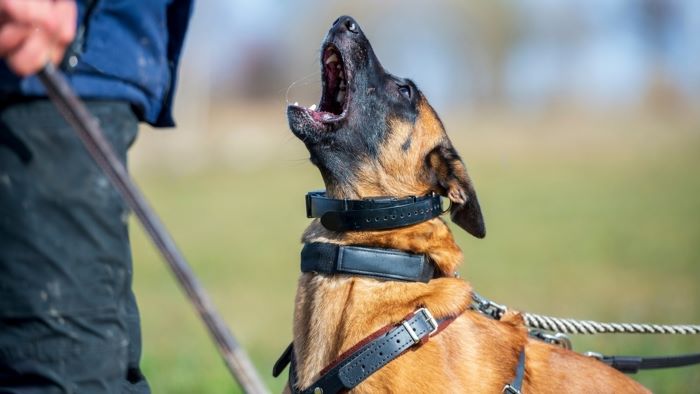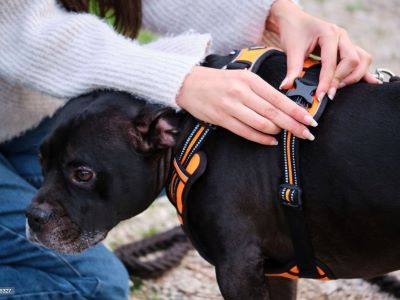Dogs are devoted friends who offer us companionship and emotional support. However, it’s important to keep in mind that since they are animals, they occasionally exhibit unpredictable behaviour. When putting on a harness, for example. Despite the fact that it can seem harmless, this method might result in dog attacks. In this article, we will discuss and denote the actual reasons why dogs bite when putting on a harness.
Why Do Dogs Bite When Putting on a Harness?

Your dog might bite at its harness when you are putting it on or later if he/she doesn’t like it. As dogs aren’t really used to wearing clothing, it’s possible that the harness isn’t correctly fitted to them and you need to make some alterations. Nevertheless, it’s also possible that they simply don’t like wearing it. There are several reasons why a dog may bite when putting on a harness.
Dogs can become fearful or anxious when they see or feel something unfamiliar, and putting on a harness can be a strange and uncomfortable experience for them. Additionally, some dogs may experience pain or discomfort if the harness is too tight or rubbing against their skin.
It is important to remember that dogs cannot communicate their discomfort or fear in the same way that humans can. Instead, they may resort to biting as a means of protecting themselves from what they perceive as a threat.
How to Prevent Dog Bites When Putting on a Harness?
Preventing dog bites when putting on a harness starts with understanding your dog’s behaviour and taking appropriate steps to make the experience less stressful. Here are some tips to help you prevent dog bites when putting on a harness:
Get Your Dog Used to the Harness:
Before putting on the harness, allow your dog to smell it and become familiar with it. You can also let your dog wear the harness for short periods of time while doing fun activities like playing or eating.
Use Positive Reinforcement:
Reward your dog with treats, praise, or toys when they behave calmly during the harness-wearing process.
Take It Slow:
Allow your dog to get used to the harness slowly. Start by putting it on for short periods of time and gradually increase the duration as your dog becomes more comfortable.
Ensure a Proper Fit:
Make sure that the harness fits your dog properly and is not too tight or loose. A well-fitting harness can help prevent discomfort and irritation.
Consider an Alternative:
If your dog continues to show fear or aggression when wearing a harness, consider using an alternative like a collar or a different type of harness.
What to Do If Your Dog Bites When Putting on a Harness:
If your dog bites when putting on a harness, it is important to take appropriate action to prevent the behaviour from continuing. Here are some steps you can take:
Stay Calm:
Reacting with anger or frustration can escalate the situation and make it worse. Stay calm and try to understand your dog’s behaviour.
Stop the Activity:
If your dog continues to show signs of fear or aggression, stop putting on the harness and try again later when your dog is more relaxed.
Seek Professional Help:
If your dog’s behaviour continues or becomes more aggressive, seek professional help from a certified dog trainer or behaviourist.
How to Put a Harness on a Dog?

The methods may differ slightly depending on the kind of harness you are using, but attaching a harness to a dog is typically a straightforward procedure. Following are some general guidelines:
Choose the right size harness for your dog:
Two fingers should fit between the harness and your dog’s skin in a correctly fitted harness, which is snug but not too tight.
Let your dog sniff and explore the harness before putting it on.
They may feel more at ease and less apprehensive about the procedure as a result.
Hold the harness open and slip it over your dog’s head.
Your dog’s shoulders should feel at ease wearing the harness.
Adjust the harness to ensure a proper fit:
Ensure sure your dog’s skin is not being rubbed or chafed by the harness, and that the straps are not excessively loose or tight.
Attach a leash to the harness if desired:
Make sure to pick the attachment point that accommodates your dog’s habit and preferred walking style.
FAQs
At what age can you put a harness on a puppy?
It is generally safe to start using a harness on a puppy when they are around 8-10 weeks old, as long as the harness is the appropriate size and fits properly. However, it is important to consult with a veterinarian or professional dog trainer before using a harness on a puppy to ensure that it is safe and appropriate for the puppy’s size, breed, and temperament.
What to look for in a dog harness?
Size and Fit: Make sure to measure your dog’s chest girth and neck circumference to find the right size harness. The harness should fit snugly but not be too tight or restrictive.
Material: Look for a harness made from durable, high-quality materials that are comfortable for your dog to wear. Nylon and neoprene are popular materials for dog harnesses.
Ease of use: Choose a harness that is easy to put on and take off, with adjustable straps that allow for a customized fit.
Safety and Features: Look for a harness with reflective strips or other safety features to ensure that your dog is visible at night or in low-light conditions.
Do dogs prefer collars or harnesses?
Harnesses are usually the best choice for walking dogs because they don’t put pressure on the neck. It is always recommended to use a harness and not a collar if you have a dog prone to breathing issues.
Should I force a harness on my dog?
Never force a harness on your dog, forcing a harness on your dog can cause fear, stress, and even physical harm, which can damage your relationship with your furry friend. It can also make your dog less likely to cooperate in the future when it comes to putting on a harness or other equipment.
Conclusion
Dog bites when putting on harness can be a common problem, but they can be prevented by taking steps to help your dog feel more comfortable with the process. By getting your dog used to the harness, using positive reinforcement, taking it slow, ensuring a proper fit, and seeking professional help when needed, you can reduce the risk of dog bites and ensure a safer experience for both you and your furry friend. Always remember to stay calm and understand your dog’s behaviour to help prevent incidents of dog bites when putting on harness.
References:
- Aggression Toward Owners is Always Problematic, but When is it Pathologic? (n.d.). The College of Veterinary Medicine at Michigan State University. Retrieved February 27, 2024, from https://cvm.msu.edu/vetschool-tails/aggression-toward-owners-is-always-problematic-but-when-is-it-pathologic
- Shih, H. (2021, September 6). Dog Pulling on the Leash: Effects of Restraint by a Neck Collar vs. a Chest Harness. Frontiers. Retrieved February 27, 2024, from https://www.frontiersin.org/articles/10.3389/fvets.2021.735680/full
- Aggression. (n.d.). ASPCA. Retrieved February 27, 2024, from https://www.aspca.org/pet-care/dog-care/common-dog-behavior-issues/aggression



